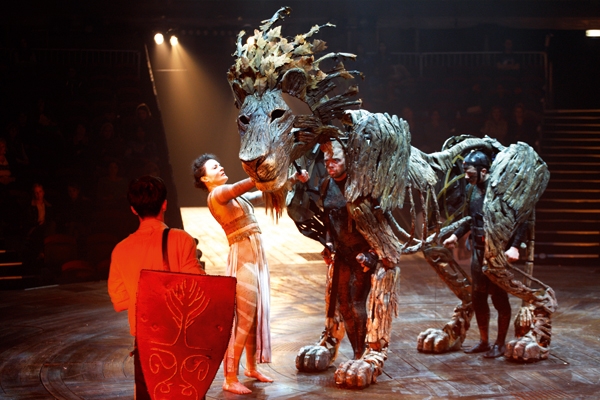Off to Narnia. Director Rupert Goold has recreated C.S. Lewis’s permafrosted fantasy world in a circus tent moored in Kensington Gardens. And at the height of summer too. An impossible feat. But tons of cash, and many months of preparation, have been sunk into this effort.
The show starts with The Wardrobe looming up in the middle of the stage, like a fat slab of mystery, a sort of Tardis perhaps, or the Kaaba at Mecca. Not much like a wardrobe, though. A child steps out and finds herself in a freaky kingdom run by a demented tundra-monger. Here she comes. Sally Dexter, playing the queen in a luminous white bedsheet, cackles sexily and yells commands at her cowering minions. Then she whooshes off in a great surge of whip cracks and dry ice. ‘Was that a bit scary?’ I said to my five-year-old son. ‘No,’ he said. ‘Was it for you?’
The children meet some beavers and together they take on the forces of evil. Aslan arrives. Everyone applauds. ‘I don’t like that Aslan,’ said the voice beside me. The head is magnificent. The eyes are black vacancies, rather than colourful gems, which deletes any spark of vitality. Aslan’s pelt is wooden rather than furry and the body is composed from its skeletal rudiments so it resembles God’s prototype instead of the finished animal.
The movements are achieved with the same three-man technology as War Horse. But not so effectively. The swivelling fluidities of a lion turn out to be quite uncapturable. So Aslan tiptoes gingerly around the stage like a holidaymaker practising his walk after a skiing accident. But the character’s essentials remain: the majesty, the melancholy, the magnetic forcefulness. And David Suchet’s voice is a wonderful purring pleasure.
The show has a lot of everything. Bangs and smoke, songs and pipes, stilt-walking and wire-dangling. The props and costumes are drawn from every culture on the planet but there’s no house style, no unifying principle. The highlights of the show are Aslan’s sacrifice, which is done with scary brilliance, and the magical disappearance of his body afterwards. But something’s not right. Narnia feels a bit room-temperature. The darkened stage, for example, is entirely free of snow. Artful video projections show us blizzards streaming and slivers of ice crystallising. But these don’t make you feel cold any more than abstract sculptures in hospitals make you feel better.
I asked for my son’s verdict as we left. ‘It didn’t take that long,’ he said. Outside we found a junior marquee cosying up to the Big Top. Here, Narnian tat was on sale at scrotum-tightening prices. A fluffy little Aslan toy, quite unlike the Aslan on stage, cost 15 quid. A T-shirt was 18 quid. There were mugs, too, queuing up to buy things. Fans of C.S. Lewis will be disheartened to see their idol playing the pimp like this. And if the producers want to push gear from the show they should stock replicas of Tom Scutt’s costumes.
At the Royal Court a new morality play from ex-teacher Vivienne Franzmann. We meet Joseph an award-winning war photographer who 20 years ago rescued a baby girl from Rwanda and raised her as his daughter. She’s called Alex. Bright but damaged, she dropped out of Cambridge and is pursuing a shelf-filling career at Sainsbury’s. Why? Well, a fellow student showed insufficient sympathy for the sufferings of Africa. And another student asked to touch her hair. So she ditched the élite and joined the underclass. Bit hard to believe, that. Her long-lost brother arrives from Rwanda and moves in with her and Joseph. At this point the play goes bananas. The siblings start an affair. At least I think that’s what happens. Joseph certainly thinks so. But are they at it or not? This rather important point is unresolved and the play pushes on to its ethical climax. The brother brings us information that compromises Joseph’s integrity. We learn, unsurprisingly, that his war journalism was motivated by vanity as well as by altruism.
Critics have lavished praise on this play perhaps fearing that to censure it might show insensitivity to the issues it raises. But Franzmann portrays the Rwandan horrors entirely from the perspective of kiddie victims. And this sentimentalises and ultimately trivialises the war. And she’s so eager to target Joseph that she stupefies him with inarticulacy at the very moment when he ought to leap to the defence of his trade. The play wants us to nod in agreement to its clunking conclusions. First, that a refugee who remains enslaved to her childhood is admirable. Second, that war journalists are parasitic, globe-trotting genocide profiteers. In fact, these heavyweight issues take up barely one twentieth of the play. The rest of it is an amiably lightweight flatshare sitcom.







Comments